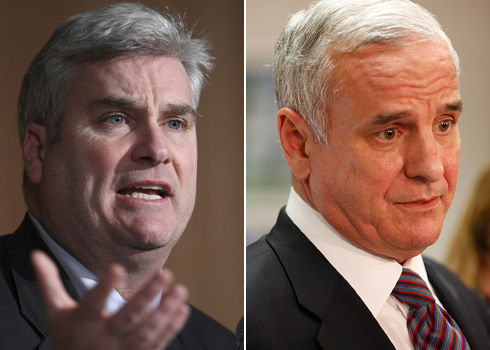The Minnesota State Canvassing Board is scheduled to meet at 11 a.m. ET today, to formally declare a recount in the gubernatorial race where Democrat Mark Dayton leads Republican Tom Emmer by less than 9,000 votes. And headed into the meeting, the Dayton campaign sent a letter to the board yesterday evening with an interesting request: Make a slight but significant change to the ballot-challenging process.
It’s impossible to know at this juncture whether the board will grant this request — and perhaps the last-minute nature of the request would lean against such a change. But it does show a clear strategy on the part of Team Dayton: With their candidate’s lead being much wider than anything Norm Coleman or Al Franken ever enjoyed in the 2008 Senate recount, they’re moving early to try to cut off any possible avenues for Emmer to slow down the process or cast doubt on the margin.
Here’s how the challenge process normally works: At all the local hand-counts across the state, representatives for the campaigns will have the right to challenge the local official’s determination for counting a ballot, based on the criteria of either voter intent (possible ambiguous markings on the ballots) or if the voter somehow invalidated their ballot (such as by signing their name on it, though some exceptions to this rule were worked out in the 2008 recount).
The challenges can then either be withdrawn by the campaign, or adjudicated by the State Canvassing Board later on. Challenges can result in a vote being counted later on, if the local official was going to disqualify it — or they can result in a ballot that would have been counted for the other guy instead being thrown out.
Now here’s the catch: When a ballot is challenged, it normally gets removed from the count entirely, pending its final judgment. In the 2008 recount, the Coleman and Franken campaigns made thousands of challenges, most of them frivolous, in an ever-escalating battle over the expectations game that played with the apparent public numbers. This resulted in Coleman seemingly keeping his lead of about 200 votes headed into the Canvassing Board meeting, even though the underlying reality was that Al Franken was pulling ahead. (After the challenges were adjudicated, and before rejected absentee ballots were reconsidered, Franken led by just under 50 votes.)
Team Dayton — whose legal team contains many familiar names from the 2008 race on the Franken side — have proposed that the state provide a running public count of the “calls at the table” for the challenged votes, before the board would adjudicate them later on. They point out that the election process already involves keeping records of those calls for the Canvassing Board’s later examination, so it would not involve new work.
“This will reduce the incentive to make frivolous challenges to create the appearance that one party or the other is making substantial gains in the hand recount,” Dayton lead attorney Charlie Nauen said, in a letter to the board that was forwarded to TPMDC by the campaign.
Even if the board doesn’t grant the request, expect the Dayton people to use this letter as a groundwork for discussion of the issue if a lot of challenges do end up occurring during the recount next week.






